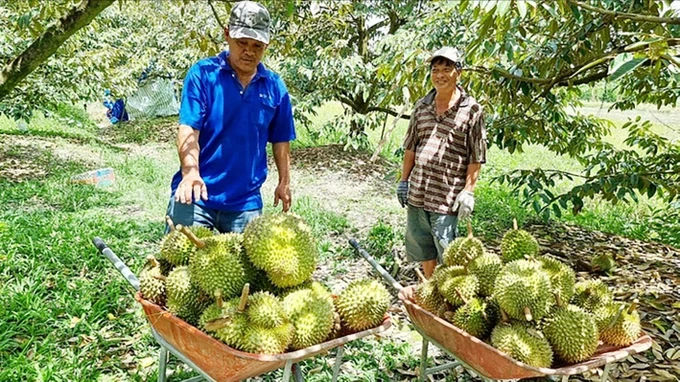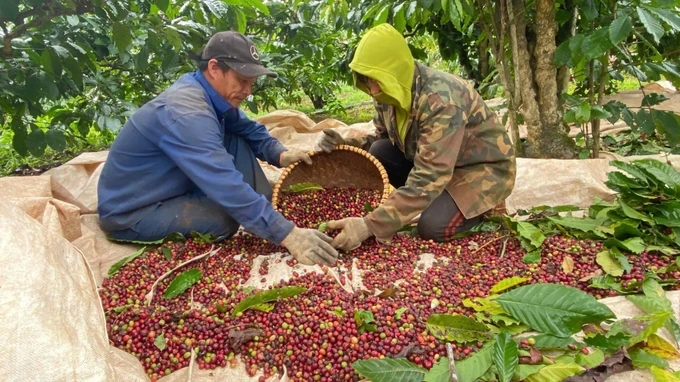
Among the star performers in Vietnam's agricultural export basket, durian has emerged as the "king of fruits". Preliminary estimates from the Vietnam Fruit and Vegetables Association (VINAFRUIT) indicate that durian exports reached US$2.5 billion in the first nine months of the year, surpassing the previous annual record of $2.24 billion set in 2023.
General Secretary Dang Phuc Nguyen of the Vietnam Fruit and Vegetables Association forecasts that Vietnam's durian exports will exceed $3 billion this year. As the main harvest season commences in the Central Highlands in October, coupled with the off-season harvests in the Mekong Delta, Vietnam's durian supply will peak.
Moreover, with competing producers like Thailand and Malaysia concluding their harvest seasons, Vietnamese durian is expected to command premium prices. Current farm-gate prices range from VND42,000 to VND 95,000 per kilogram, ensuring substantial profits for farmers.
Although durian prices this year are slightly lower than the previous year, they have been more stable. This has facilitated smoother procurement and ensured the fulfillment of export orders. The superior quality and competitive pricing of Vietnamese durian compared to Thai products have boosted export volumes, particularly to the Chinese market.

Another agricultural product experiencing significant growth is coffee. In the first nine months of the year, Vietnam exported over 1.1 million tonnes of this produce, generating over $4 billion in revenue. Despite a decline in volume, the value of coffee exports increased by 30 percent.
Similarly, rice exports reached nearly $4 billion, while fruit and vegetable exports surpassed $4.8 billion. Both are forecast to have significant breakthrough in export turnovers.
According to the Ministry of Agriculture and Rural Development, the export market has shown signs of robust growth, with inventory turnover times decreasing from 1-2 months in the first and second quarters to just 1-3 weeks in the fourth quarter.
This indicates a strong demand for Vietnamese agricultural products, especially as the year-end holiday season approaches. Proactive measures such as securing raw materials, enhancing deep processing, and diversifying export markets will further bolster Vietnam's agricultural exports.
Moreover, global challenges have presented opportunities for Vietnamese agricultural products to penetrate new markets like Japan, the Republic of Korea, the Philippines, and Europe. As of September 2024, Vietnam's total agricultural, forestry, and fishery exports reached nearly $50 billion, marking a 20-percent increase year-on-year.
Despite these positive developments, the agricultural export sector still faces various challenges, including natural disasters, rising freight costs, and a shortage of products meeting international standards.
To address these issues, the government is emphasizing the importance of improving product quality, diversifying export markets, and leveraging trade agreements.
Beneath the positives of Vietnam's agricultural export growth, a myriad of challenges persists. Natural disasters have caused significant damage, leading to supply chain disruptions and increased transportation costs. Furthermore, the inadequate supply of export-quality produce, traceable to specific growing regions, has become a pressing issue.
The lack of comprehensive production planning and market forecasting also remains a significant concern. The rapid growth of certain agricultural products has outpaced regulatory frameworks, leading to potential risks associated with overreliance on specific markets.
General Director Nguyen Dinh Tung of Vina T&T Co. emphasized the need for Vietnam's agricultural products to meet stringent food safety and technical standards to remain competitive in the global market. He stressed the importance of diversifying export markets and enhancing the technical barriers to trade for Vietnamese fruits to ensure sustained growth.
Deputy Minister Phung Duc Tien of Agriculture and Rural Development expressed confidence in achieving the target of $55 billion in agricultural exports for 2024. To realize this goal, the ministry will focus on deepening processing capabilities, building strong brand identities for Vietnamese agricultural products, and promoting trade facilitation.
By leveraging international trade agreements such as the Comprehensive and Progressive Agreement for Trans-Pacific Partnership (CPTPP) and the Vietnam-EU Free Trade Agreement (EVFTA), Vietnam aims to expand its market reach and support enterprises in securing new export orders.
While traditional markets like China, the US, Japan, and Europe remain priorities, the ministry is also actively exploring opportunities in emerging markets such as the Middle East and Africa. These strategic initiatives are designed to foster long-term growth and sustainability in Vietnam's agricultural sector.
























